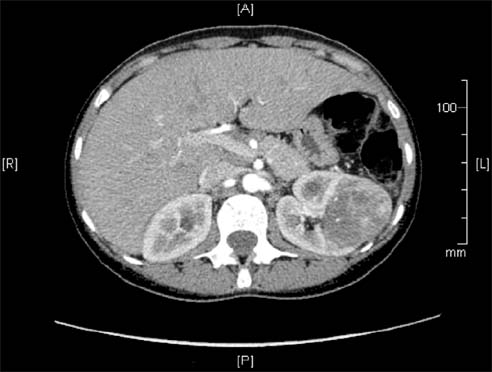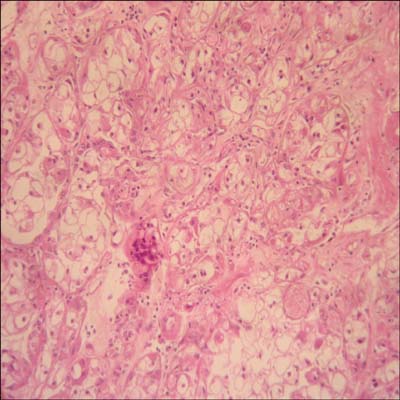Korean J Urol.
2014 Feb;55(2):145-147. 10.4111/kju.2014.55.2.145.
Translocation Renal Cell Carcinoma t(6;11)(p21;q12) and Sickle Cell Anemia: First Report and Review of the Literature
- Affiliations
-
- 1Department of Urology, Rennes University Hospital, Rennes, France. damienchaste@gmail.com
- 2Department of Urology, Pointe a Pitre University Hospital, Guadeloupe, France.
- KMID: 1988442
- DOI: http://doi.org/10.4111/kju.2014.55.2.145
Abstract
- Translocation renal cell carcinoma (RCC) is a family of rare tumors recently identified in the pediatric and young adult population. We report the first case of a young woman from French West Indies with sickle cell anemia who developed a translocation RCC t(6;11)(p21;q12). Usually people with the sickle cell condition are known to develop renal medullary carcinoma (RMC). To our knowledge, this is the first case described in the literature of a translocation RCC associated with sickle cell disease. Here we discuss the relation between translocation RCC, RMC, and sickle cell disease.
Keyword
MeSH Terms
Figure
Reference
-
1. Geller JI, Argani P, Adeniran A, Hampton E, De Marzo A, Hicks J, et al. Translocation renal cell carcinoma: lack of negative impact due to lymph node spread. Cancer. 2008; 112:1607–1616.2. Camparo P, Vasiliu V, Molinie V, Couturier J, Dykema KJ, Petillo D, et al. Renal translocation carcinomas: clinicopathologic, immunohistochemical, and gene expression profiling analysis of 31 cases with a review of the literature. Am J Surg Pathol. 2008; 32:656–670.3. Davis CJ Jr, Mostofi FK, Sesterhenn IA. Renal medullary carcinoma: the seventh sickle cell nephropathy. Am J Surg Pathol. 1995; 19:1–11.4. Srigley JR, Delahunt B. Uncommon and recently described renal carcinomas. Mod Pathol. 2009; 22:Suppl 2. S2–S23.5. Tsaras G, Owusu-Ansah A, Boateng FO, Amoateng-Adjepong Y. Complications associated with sickle cell trait: a brief narrative review. Am J Med. 2009; 122:507–512.6. Raynal G, Bracq A, Tillou X, Limani K, Petit J. Renal complications of sickle-cell anaemia. Prog Urol. 2007; 17:794–795.7. Swartz MA, Karth J, Schneider DT, Rodriguez R, Beckwith JB, Perlman EJ. Renal medullary carcinoma: clinical, pathologic, immunohistochemical, and genetic analysis with pathogenetic implications. Urology. 2002; 60:1083–1089.8. Argani P, Lae M, Hutchinson B, Reuter VE, Collins MH, Perentesis J, et al. Renal carcinomas with the t(6;11)(p21;q12): clinicopathologic features and demonstration of the specific alpha-TFEB gene fusion by immunohistochemistry, RT-PCR, and DNA PCR. Am J Surg Pathol. 2005; 29:230–240.9. Argani P, Ladanyi M. Translocation carcinomas of the kidney. Clin Lab Med. 2005; 25:363–378.
- Full Text Links
- Actions
-
Cited
- CITED
-
- Close
- Share
- Similar articles
-
- Salmonella Typhi Osteomyelitis in a Non-sickle Cell Patient: Three Cases Report
- The Expression of Caspase 3 and p21 in Renal Cell Carcinoma
- A Case of Renal Cell Carcinoma in Childhood
- Genotypic influence of alpha-deletions on the phenotype of Indian sickle cell anemia patients
- A Case of Sickle Cell Anemia with a Lack of High Frequency Red Blood Cell Antigen



